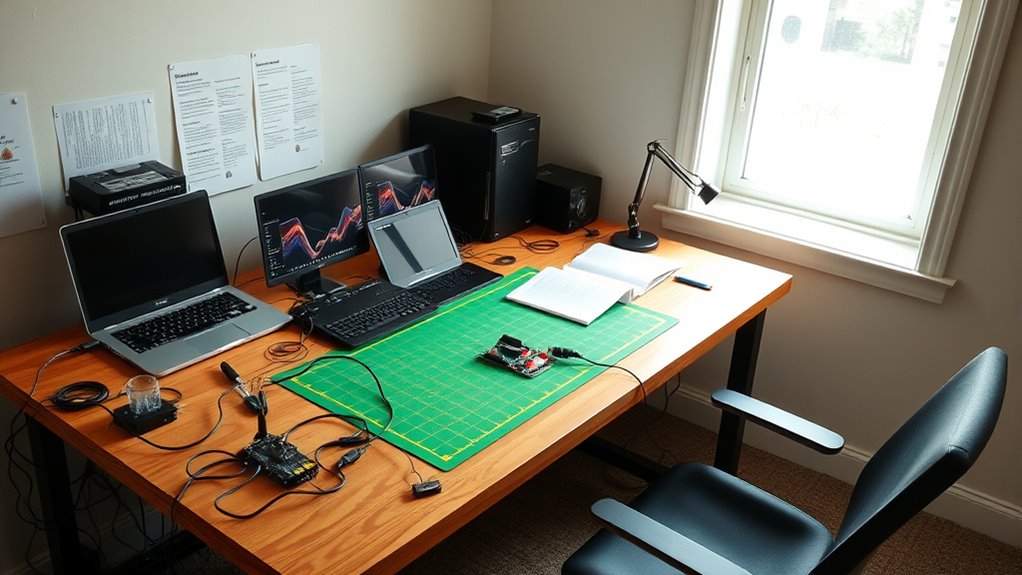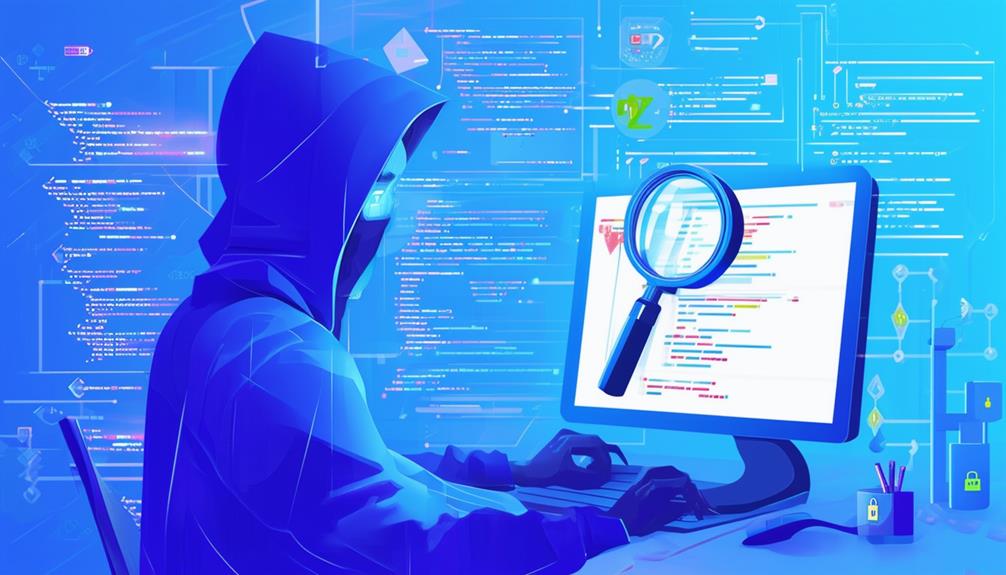To build a budget-friendly home hacking lab under $500, start by choosing affordable hardware like used Raspberry Pi or Nvidia Jetson boards, and pair them with a reliable router supporting VLANs for network segmentation. Use open-source tools like VirtualBox or VMware for virtualization, and set up isolated environments with VMs and containers to test security tools safely. Focus on securing your network with firewalls like pfSense. Continue exploring the best practices and resources to enhance your setup effectively.
Key Takeaways
- Select affordable, small-form-factor devices like Raspberry Pi, Nvidia Jetson, or used SBCs to keep costs under $500.
- Use open-source virtualization platforms (VirtualBox, VMware) to run multiple testing VMs on budget-friendly hardware.
- Segment your network with VLANs and deploy open-source firewalls like pfSense for secure, isolated environments.
- Incorporate free or low-cost cybersecurity tools (Kali Linux, Wireshark, Nmap) within virtual environments for attack and defense practice.
- Leverage online communities, free resources, and simulated platforms like TryHackMe to enhance skills without extra costs.
Planning Your Budget and Selecting Essential Hardware

When planning your home hacking lab, start by establishing a clear budget to guide hardware choices. Focus on a virtualization-capable CPU, as modern processors support this feature, enabling efficient VM management. Allocate at least 6-8GB of RAM for basic operations, but aim for 16GB or more if you plan to run multiple virtual machines simultaneously. Budget for storage solutions that balance speed and cost, like SSDs for faster performance or HDDs for affordability. Don’t forget to consider power supply and backup options, such as a UPS, to keep your lab running during outages. Additionally, plan for network hardware—routers supporting advanced features and quality Ethernet cables—to ensure reliable and secure connectivity. Choosing reliable hardware can prevent future compatibility issues and save money in the long run. Incorporating sustainable and eco-friendly decor choices into your setup can also help reduce energy consumption and promote efficiency. Keeping these essentials in mind helps you build a solid foundation without overspending.
Choosing Cost-Effective Single-Board Computers and Used Equipment
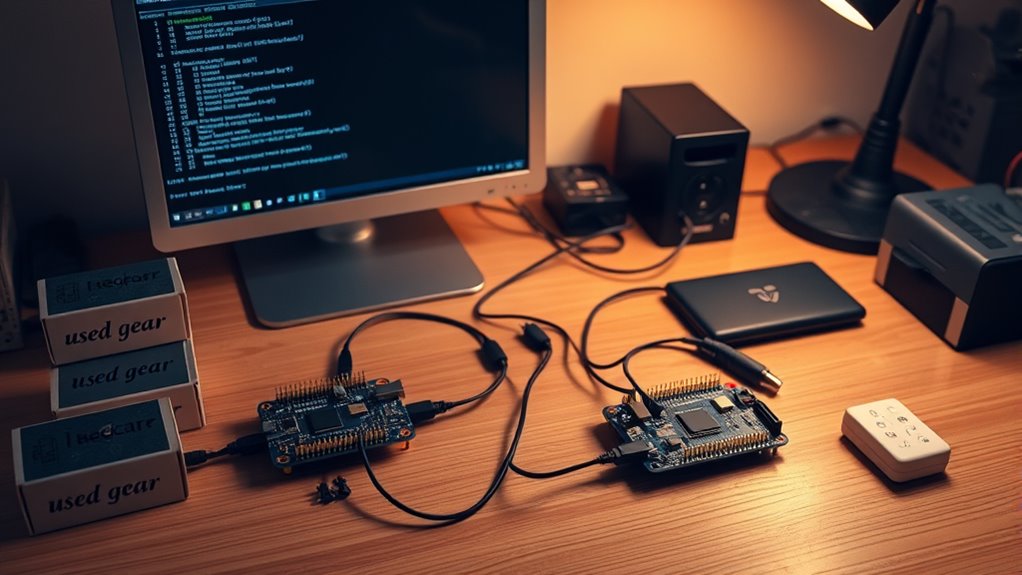
Opting for cost-effective single-board computers (SBCs) and used equipment is a smart way to build a capable home hacking lab without overspending. Raspberry Pi models are popular due to their affordability and versatility, with options like the Pi Zero for small projects and the Pi 5 for more demanding tasks. Nvidia Jetson modules excel at AI projects, offering high performance with models like the Jetson Nano and AGX Orin. The Atmel SAMA5D2 provides Linux support for moderate processing needs. Using resources like HackerBoards helps you find the best SBCs for your requirements. Buying used or refurbished SBCs from online marketplaces, local IT disposals, or hardware recycling centers can save money. Researching compatibility and support before purchasing ensures your equipment will work smoothly for your intended projects. Exploring single-board computer options that support your specific project goals can help optimize your setup. Repurposing old computers and networking gear further reduces costs while expanding your lab’s capabilities.
Setting Up a Robust and Secure Network Infrastructure
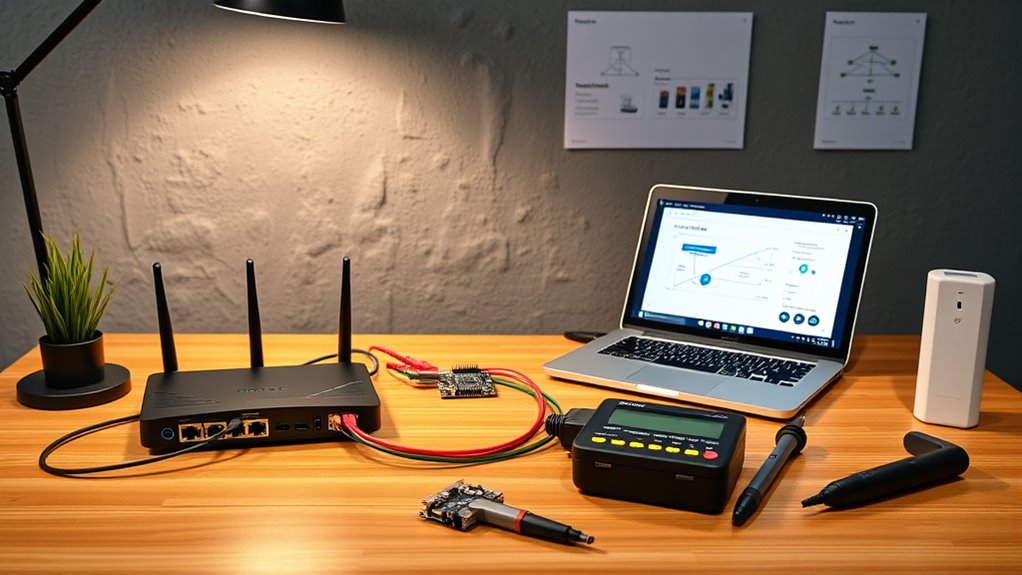
Building a secure and reliable network infrastructure is essential for maintaining the integrity of your home hacking lab. Start by segmenting your network using virtual networking features or VLANs on managed switches to isolate your lab from your main network. Use multiple virtual network adapters per VM—such as NAT for internet access and Host-Only for isolation—and assign different subnets (e.g., 192.168.x.x, 10.x.x.x) to keep attacker and target machines separate. Disable outbound connectivity on vulnerable VMs to prevent leaks. Deploy open-source firewalls like pfSense to control traffic, restricting access to necessary ports. Change default device credentials, update firmware regularly, and document configurations. Use static IPs for key VMs, implement DNS entries, and monitor traffic with logging and analysis tools to enhance security and manageability. Implementing network segmentation helps prevent potential breaches from spreading across your entire home network. Additionally, configuring network monitoring tools can provide real-time insights into suspicious activity, further strengthening your security posture.
Installing and Configuring Key Software Tools and Virtualization Platforms

To establish a functional home hacking lab, you need to install and configure essential virtualization platforms and security tools. Choose software like VirtualBox, VMware, or Hyper-V to host multiple virtual machines. Once set up, install key tools tailored to your learning goals. For example, Kali Linux offers over 600 pre-loaded penetration testing tools, while Metasploit helps develop exploits. Network analysis tools like Nmap and Wireshark reveal network activity. Use the table below to visualize how these components fit together:
| Virtualization Platforms | Security & Testing Tools |
|---|---|
| VirtualBox / VMware | Kali Linux, Metasploit, Burp Suite, Nmap, Wireshark |
| Hyper-V | Nikto, SQLmap, Snort, Security Onion, Netcat |
| Ghidra, OllyDbg, IDA Pro, Radare2, Binwalk | |
| John the Ripper, Hashcat, Hydra, Python, Bash |
| Virtualization platforms also support the integration of additional security tools, enhancing your testing environment.
Creating Isolated Virtual Environments for Safe Testing
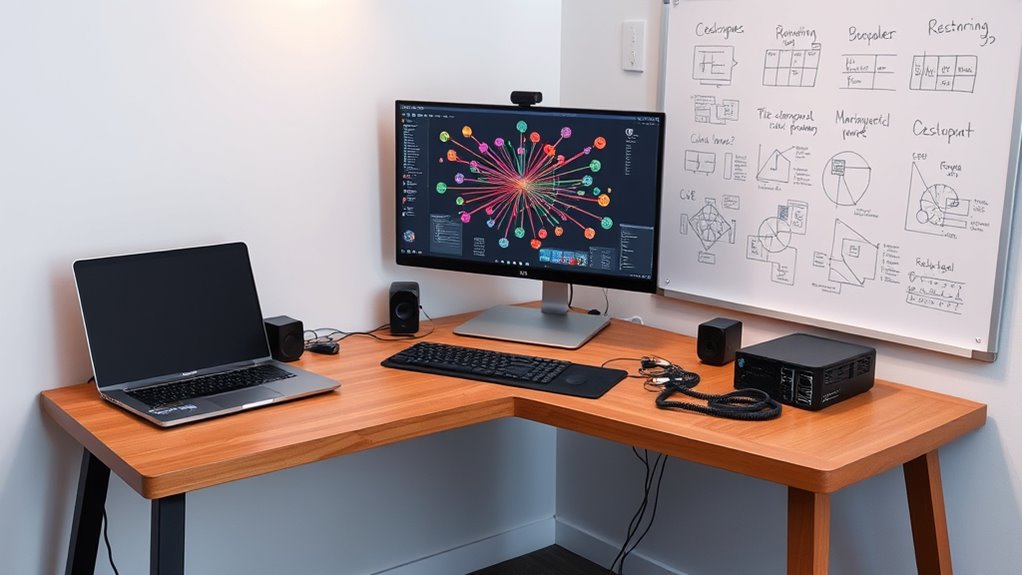
You can keep your testing safe by setting up isolated virtual environments that prevent malware from spreading. Using virtual machines and network segmentation, you control traffic and restrict access to sensitive systems. This approach guarantees your main network stays secure while you experiment freely. Additionally, virtualization sandboxing allows you to analyze suspicious files or software in a controlled environment, minimizing potential damage. Incorporating emotional support principles, such as maintaining calm during testing, can help reduce stress and foster a more effective learning experience.
Virtual Network Segmentation
Virtual network segmentation is a crucial technique for creating isolated virtual environments that enable safe testing within your home hacking lab. By dividing a flat virtual network into multiple subnetworks, you enhance security boundaries and prevent threats from spreading. Techniques like VLANs, virtual firewalls, and SDN enable you to logically separate traffic without physical changes. Each segment can enforce its own access controls, reducing your attack surface and preventing lateral movement of threats. Segmentation also supports secure testing by isolating vulnerable systems from your main network. You can assign distinct IP subnets, control traffic flow with virtual appliances, and use hypervisor-level controls like virtual switches. Regularly auditing your segmentation maintains security, making your home lab safer and more manageable for testing. Additionally, understanding network segmentation helps you optimize your setup for both security and performance.
Using Virtual Machines
Creating isolated environments within your home hacking lab is made possible by deploying virtual machines (VMs). VMs segregate processes, preventing malicious software from spreading beyond their boundaries. Each VM operates independently, so if one is compromised, others and the host stay safe. This process isolation enhances overall security by containing threats within individual VMs. To make the most of VMs, consider these key benefits: Mad Tasting allows you to experiment with different flavors and recipes safely without affecting your main system.
Isolated Testing Environments
Establishing isolated testing environments is essential for safely evaluating software and analyzing security threats. These environments create a segregated computing space using hardware, virtual machines, or containers, keeping test activities separate from your main systems. The goal is to prevent tests from interfering with or contaminating live operations, ensuring both test integrity and system safety. Mirroring production specs helps verify system requirements before deployment. You can achieve isolation through separate networks, virtual machines, or containers like Docker. This setup allows you to test new code, analyze malware, and experiment with untrusted applications without risking your main network. Properly managed, isolated environments reduce risks, protect critical data, and enable thorough testing of complex systems in a controlled, secure manner. Isolated test environments also facilitate compliance with security standards by providing a clear audit trail of testing activities.
Implementing Practice Scenarios With Simulated Attacks and Defense Strategies

You’ll want to design attack simulations that mimic real-world threat scenarios, such as vulnerability scans and exploitation attempts. At the same time, develop defense exercises that focus on detection, logging, and incident response to strengthen your skills. Incorporating training exercises that simulate actual cyberattacks helps bridge the gap between theory and practice, enabling more effective learning. Combining these approaches helps create an all-encompassing environment for practicing both offensive and defensive cybersecurity strategies. To ensure your lab remains effective and realistic, regularly incorporate automation tools to simulate complex attack patterns and defensive responses, which enhances your ability to handle real-world situations.
Designing Attack Simulations
Designing effective attack simulations begins with selecting realistic scenarios that align with your home lab’s scope and your skill level. To do this:
- Choose threats relevant to your environment, like phishing, malware, or web exploits, using threat intelligence to mimic real attacker groups and malware types.
- Balance complexity and achievable results by prioritizing scenarios that fit your budget and resources, updating them regularly to reflect emerging threats.
- Incorporate diverse attack vectors, such as email phishing, web app exploitation, and denial-of-service, to develop all-encompassing skills in both offensive and defensive tactics. Additionally, consider integrating attack surface awareness to better understand potential vulnerabilities within your network.
- Remember that company-wide incident response strategies, such as communication protocols, are essential to handle real-world breaches effectively during your simulations.
Ensure each scenario is contained within your isolated environment, with clear boundaries and safety measures like snapshots. This approach keeps simulations realistic, engaging, and manageable.
Developing Defense Exercises
Implementing effective defense exercises involves creating realistic practice scenarios that simulate actual cyber threats. Live-fire exercises help you respond to real-world attacks, boosting your team’s technical skills and coordination under pressure. These exercises encourage collaboration among stakeholders, ensuring everyone understands their role during a breach. Monitoring and analyzing simulated attacks in a controlled environment sharpen your detection and response tactics. Stress-testing defenses helps identify weaknesses and improves your decision-making speed. Benchmarking using standardized scenarios allows you to measure progress over time. Additionally, tabletop exercises focus on discussion-based scenarios, such as social engineering or malware incidents, enhancing your team’s strategic thinking. Incident response drills simulate crisis management, helping you practice swift breach detection and containment. Designing realistic injects guarantees exercises reflect daily threats, preparing you for actual cyber incidents. Understanding cybersecurity laws and compliance requirements ensures that exercises remain within legal boundaries and promote best practices.
Maintaining, Upgrading, and Securing Your Home Hacking Lab

Maintaining, upgrading, and securing your home hacking lab are vital steps to guarantee it remains reliable, effective, and safe. To do this, you should:
- Schedule regular hardware, VM, and network checks to ensure everything runs smoothly.
- Monitor logs for anomalies or unauthorized access attempts across all systems.
- Update software and OS immediately after patches are released to close vulnerabilities.
Additionally, it’s imperative to:
- Back up configurations, scripts, and VMs regularly to prevent data loss.
- Harden security by isolating your lab network with VLANs or firewalls.
- Enforce strict access controls, disabling unnecessary ports and using key-based SSH authentication.
Consistent maintenance keeps your lab secure and ready for testing, learning, and growth.
Leveraging Resources and Community Support for Continuous Improvement

Leveraging resources and community support is essential for continuously improving your home hacking lab, as it allows you to access new tools, insights, and expertise. By engaging with active learner groups, forums, and open-source projects, you stay updated on the latest cybersecurity techniques. Cloud-based platforms like TryHackMe and HackTheBox offer accessible, gamified environments for practice and growth, without setup hassle. Connecting with communities provides feedback, collaboration opportunities, and shared knowledge. Use the table below to see how different resources support your learning journey:
| Resource Type | Benefit |
|---|---|
| Ethical Hacking Tools | Hands-on practice and skill development |
| Learning Communities | Networking and expert support |
| Cloud-Based Solutions | Flexibility and anytime learning |
| Educational Resources | Structured knowledge and tutorials |
Frequently Asked Questions
How Can I Ensure My Home Lab Adheres to Legal Cybersecurity Practices?
You want to make sure your home lab follows legal cybersecurity practices. First, keep your lab isolated from your main network using VLANs or virtual machines. Always get permission before testing on any external systems. Follow an ethical framework, stay aware of local laws, and avoid malicious activities. Regularly update software, back up data, and control access to prevent security risks. Engage with reputable resources for ongoing learning and stay compliant.
What Are the Best Methods to Maximize Budget Efficiency for Hardware?
To maximize your budget efficiency, start with existing hardware like old computers or laptops that support virtualization. Shop second-hand or on eBay for affordable mini PCs or older models. Focus on essential components like RAM and SSDs to boost performance without overspending. Use free virtualization and open-source cybersecurity tools. Upgrade gradually, monitor resource use, and leverage community support to keep costs low while maintaining a functional, scalable home hacking lab.
How Do I Secure My Virtual Environments From External Threats?
Imagine your virtual environment as a fortress needing robust defenses. You secure it by enabling multi-factor authentication, restricting access with role-based controls, and regularly auditing permissions. Use hypervisor security features to lock down your setup, automate patches to fix vulnerabilities, and encrypt data in transit. Implement network segmentation, firewalls, and VPNs to isolate and protect critical systems. Monitoring logs and conducting audits help catch threats early, keeping your virtual fortress safe from external attacks.
Which Virtualization Platforms Are Most Compatible With Low-Cost Hardware?
You want to know which virtualization platforms work best with low-cost hardware. You’ll find Oracle VM VirtualBox ideal because it’s lightweight, runs on multiple OS, and supports modest resources. Microsoft Hyper-V, built into Windows, offers good performance on budget systems with hardware-assisted virtualization. Xen and XCP-ng are open-source, flexible options for low-end hardware, while Proxmox VE provides efficient resource use and supports both virtualization and containers, making them all suitable choices for affordable setups.
How Can I Troubleshoot Network Issues in a Small Home Lab Setup?
To troubleshoot network issues in your small home lab, start by checking your device’s IP, subnet mask, and gateway settings to make certain they match. Use command-line tools like `ipconfig` or `ifconfig` to gather info. Inspect physical connections and cables for damage. Scan your network with tools like Nmap or analyze traffic with Wireshark. Test and verify connectivity after making changes, and keep records of your troubleshooting steps for future reference.
Conclusion
Building your home hacking lab for under $500 is totally doable with careful planning and smart choices. For example, imagine setting up a beginner-friendly lab using a used Raspberry Pi and open-source tools, allowing you to practice ethical hacking safely. Stay curious, keep learning, and leverage online communities for support. With dedication, you’ll develop real skills and stay ahead in cybersecurity—all without breaking the bank. Happy hacking!
